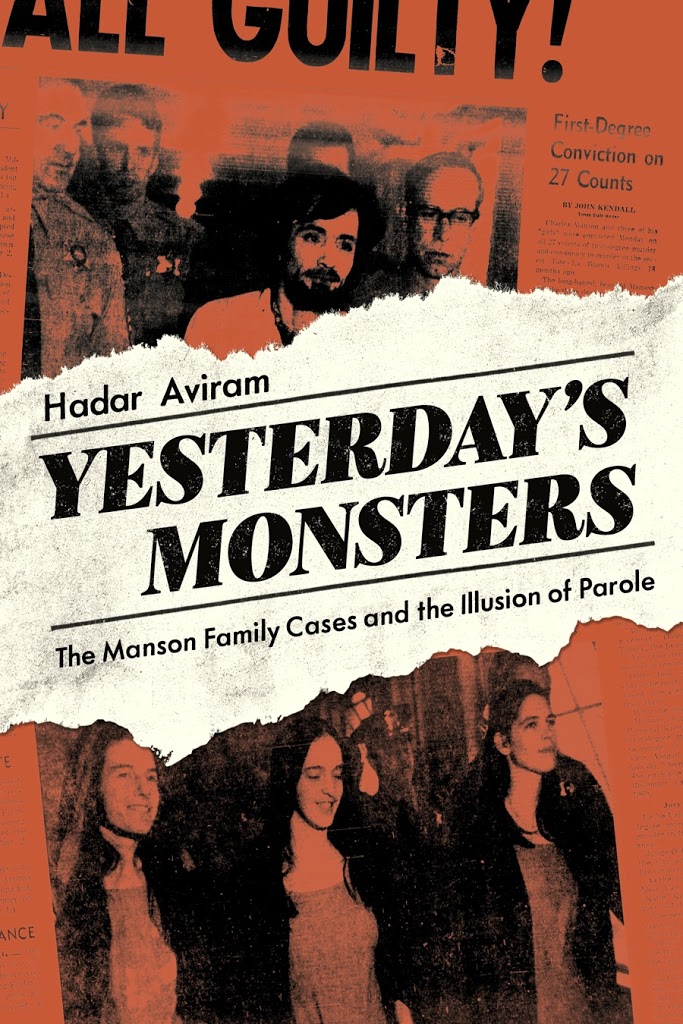To whet your appetite, this is an excerpt from my book in progress, Yesterday’s Monsters, under contract with the University of California Press.
On November 19, 2017, Charles Manson died in prison. His death sparked renewed interest in the killings, as well as in the peculiar legal circumstances that led to the commutation of his sentence, from the death penalty to life with parole. Little attention, however, was paid to the implication of his commuted sentence: since 1978, Manson attended 11 parole hearings, and was denied parole in each and every one of them.
My book in progress, Yesterday’s Monsters (under contract with UC Press) analyzes close to 50 years’ worth of parole hearing transcripts for Manson and his disciples. To-date, only one of them, Steve Grogan, was released. The remaining members of the Manson “family” have been repeatedly denied parole. Most remarkably, Susan Atkins, who was already seriously and terminally ill at her last hearing to the point of being nonresponsive, was not released on account of posting a risk to the community.
Yesterday’s Monsters analyzes the parole hearing and shows it to be an intricately choreographed spectacle, with a given structure, specific terms and buzzwords, and expectations as to the inmate’s performance. Time after time, most defendants in the case show up for the hearings and are denied parole. The one exception was Manson himself, who to his death played his own game with the parole board, speaking off the record, providing strange statements, and refusing to go along with the plan.
It would be easy to dismiss Manson’s behavior as a symptom of mental illness. While possible, this is only one facet of his behavior. It is especially revealing to see how the parole board attempted to deal with his last three parole hearings, to which Manson did not show up, and in which he did not cooperate with his representing attorneys.
***
1997 was the last year in which Manson attended his parole hearings. His 2002 hearing was held in the presence of his state-appointed attorney, Patrick Sparks. The Commissioner addressed Sparks as follows:
Mr. Patrick Sparks has been appointed by the State to represent Mr. Manson. Mr. Manson refused to meet with Mr. Sparks. Therefore, Mr. Sparks is at a substantial disadvantage and has indicated that he would like to be removed or dismissed from this case. Mr. Sparks, would you like to?
ATTORNEY SPARKS: That’s an accurate statement, and I’ll confirm that. That, in fact, Mr. Manson did not interview and I don’t believe that my participation at this hearing would facilitate his parole at this time.
[1]As a consequence, the Board officially removed Mr. Sparks from the case and declared a recess,
[2]after which the Commissioner made a statement about the way in which the committee would have respected Manson’s rights—had he been present:
Were Mr. Manson to appear today, he would not have been required to discuss the commitment offense with the Panel. He would not have been required to speak to the Panel. Nor would he be required to actually discuss any aspects at all with the Panel. Again, he has chosen not to appear at all. And had he — Because he’s refused to attend, and had he decided not to speak to us, we would not and will not hold that against him.
[3]The panel then proceeded to read the verbatim description of Manson’s crime, as they had done at the hearings at which he was prensent. They then quoted Manson as refusing to express remorse at his 1997 appearance, which was in 1997—in contrast to his verbatim statement, in which he actually challenged the court’s findings by claiming he had not given an order to kill the victims.
[4]The board tried to make sense of Manson’s file in his absence, without much success:
In a previous report, Mr. Manson stated that in terms of parole plans, he had none. He’s had a variety of responses to that question or that issue. At one point in 1992, he stated he wasn’t interested in paroling. He would be lost in our society, and his main concern was to be released to a general population setting in order to program. There are a number of letters in the file. There are a total of 80 signatures on a petition. The signatures all appear to come from people in England. There are 15 different form letters or individual letters in the file, all of these supporting release for Mr. Manson. And the letters are signed by people who seem to be scattered all over the United States, the 15 letters.
[5]By counterbalance, the police department had provided a letter as well, which cited the original crime and the “risk to the community” posed by Manson, but did not elucidate whether said risk was current, or stemmed from anything beyond the crimes themselves:
[The Commander Officer of the Robbery/Homicide division] writes that Mr. Manson was an active participant in the mutilation and murders of several persons in the Los Angeles area. Crimes committed by Mr. Manson were of such brutality and complete lack of humanity that it is clear Mr. Manson has no concern for human life. It is the opinion of the Los Angeles Police Department that the release of Mr. Manson will create considerable risk to the community and that his release is unequivocally contrary to the interests of society.
Commissioner Mackenberg recited Manson’s unhappy and unproductive prison experience and his disciplinary violations, concluding that—
[B]y and large he has not had a very happy time of it in the last five years. If it sounds like a woeful tale, it’s not because I’m trying to simply disrespect Mr. Manson, it appears that he has serious mental health issues. That they’re causing him some very real problems.
[6]Mackenberg’s summary is as much a failure of the California prison system as it is Manson’s:
The long and short of it is, is that it’s difficult to say a whole lot about the last five years other than that he seems to go back and forth between the Protective Housing Unit, Administrative Segregation, Security Housing, back to Protective Housing Unit. So that’s kind of like a sad circle of rounds in this institution. He doesn’t seem to benefit a whole lot from treatment inasmuch as he resists it so that he often refuses apparently to see the psychologist and doesn’t want to see psychiatrists and that it’s difficult to get him to do the things that they think he should do in order to forward his programs to be able to come to the Board at some point and say really, I ought to be able to go home.
Kay, the original prosecutor, again discusses Manson’s manipulations. He also provides, again, an inaccurate characterization of Manson’s legal position:
He has never understood why he was convicted for these murders because he always thought that if he got other people to commit the murders, then they could be convicted of the murders. But if he didn’t physically do it, then he couldn’t be convicted.
[7]As mentioned before, Manson claim was not that he could not be convicted without physical participation in the crime. His factual contention was that he had not ordered the others to kill the victims. But Kay hits the nail on the head with the following observation:
He knows that he’s never going to get paroled, and he’s just not going to go along with the program.
[8]Last to speak before Manson’s expected denial of parole was Debra Tate, who evinced enough familiarity with the parole board to say:
I’m a little disappointed that Mr. Manson chose not to show up today. However, in order not to waste any time, I also believe that Mr. Manson, for obvious reasons, should be denied parole for five years. I implore you to please give him the five years so that I don’t have to come and see you folks again so soon, although I love you dearly. He is totally unsuitable for release into society in my opinion, and I implore you to please keep him in so that society can have peace for at least five more 13 years.
[9]At his subsequent parole hearing in 2007, not only did Manson not show up, but he was unrepresented before the committee, and the Comissioner stated to the record the board’s intention to “do everything we can to ensure that his rights have not been violated.” She then stated Manson’s rights for the record, but this time, she did it more theatrically, as if narrating a hypothetical play in which Manson had showed up for his hearing, which makes his absence even more glaring:
[A]t this point I would have asked him did he review his Central File, did he get a timely notice of the hearing. It appeared that he did. He declined and refused to sign whether or not he was going to review his C-File, and that was done on January the 23rd 15 , 2007. And also there were no relevant documents that he had to produce. We would always ask that at this time as well. I would also ask him if he had – let him know that he had an additional right to be heard by an impartial Panel, and again, since he’s not here, I would assume he does not object to the Panel. I would also — the nextitem that I would ask him is — and let him know that he would not be required to either discuss his offense if he desires not to do so and we cannot hold that against him, but however, we do accept the finding of the court to be true.
[10]The absurdity of this play in absentia—not only of Manson, but of a representing attorney as well—is an illustration of Kay’s insight from the 2002 hearing: The board had come prepared to play under certain rules and Manson, by virtue of his absence, forced them into a role they did not intend. To compound matters, his lack of willingness to cooperate with his psychiatrist led to a diagnosis based on partial information—antisocial personality disorder and psychopathy.
[11]The panel then mentioned a support letter:
We do have a support letter and it’s dated – it was received in the institution on January 24th 26 , 2007, but it’s undated and it’s from a Carol Gallego. . .
She indicated she was only 13 years old when the inmate came to prison and she’s never met the man, but all she’s ever heard about and learned from is by books and news media, and then she wrote some things that she said that bothers her about the – his incarceration, and she indicated that she thinks it’s time to set this innocent man free. “Please consider initiating a further investigation” and I won’t go into all of the details of what was said about and the five items that she brought up in this support letter for the inmate.
[12]The prosecutor, Sequeira, provided a standard narrative closely following the demonic Bugliosi story, very similarly to Kay before him. Notably, and by contrast to the police and the prosecution. Debra Tate actually provided an argument for current risk posed by the inmate:
I would like it to go on the record that I disagree with some of the things read in the Central File. I believe that Mr. Manson has one very prolific talent and that talent is to pick sociopaths. That is the same reason in which he should never be granted any kind of a release. There are still people that are influenced by him. They grow in numbers every day via the Internet, and in regards to that, anyone of these people being released poses a great public safety issue.
[13]The board’s frustration with having had to play Manson’s game was evident in their decision as well:
We’d like to also go on record to state that we feel that Mr. Manson should be attending these hearings, these suitability hearings, in order for the Panel to be able to discuss and clarify any discrepancies that may be in his record, that he constantly said that this or that is not here, and we could also question him on some of the various conflicting versions that he’s given as relationship to the crimes.
[14]Manson’s last parole hearing, which he also did not attend, was held in 2012. However, this time Manson was represented by a new attorney, Dejon Lewis, who by contrast to Sparks tried to provide representation for the client who did not cooperate with him
[15], by making both legal and factual points. Notably, Commissioner Peck, perhaps frustrated with Manson’s absence, chose to address him in the second person throughout the hearing, as if to force engagement on him:
And Mr. Manson, I’m speaking to you through the record now. We have reviewed your Central File. We’ve reviewed your prior transcripts, and nothing that happens here today is going to change the court findings. We’re not here to retry your case. We’re going to accept as true the findings of the court. We’re here for the sole purpose of determining your suitability for parole.
[16]As the hearing began, Lewis presented a legal objection to the timing of the parole hearings. As mentioned above, Marsy’s Law, an ostensibly pro-victim legislative initiative, increased the time between parole hearings to an initial 15 years, and it was applied to cases of people serving current prison terms, even if they had originally been incarcerated long before its enactment. Lewis made the argument that the law should not apply retroactively, and Peck summarily dismissed his argument.
[17]Peck proceeded to quote Manson’s interview with the prison psychiatrist:
“I am special. I am not like the average inmate. I have put five people in the grave. I have been in prison most of my life. I am a very dangerous man.” Further in the psychological assessment, he stated, “I don’t care about the Board’s opinion. I don’t care about your opinion.”
[18]As Peck reviewed the psyhicatrist’s diagnosis, he read this observation:
Clinically, while limited, this indicates some degree of improved insight into his violent and anti-social behavior considering his previous pattern of denial of wrongdoing.
[19]Once more, a solitary support letter was presented on Manson’s behalf, which Peck leaned toward dismissing as vague:
There is a letter by an individual named John E. Ashcraft that says he’s Mr. Manson’s best friend and there’s — I really don’t know if this is even a legitimate letter or not a legitimate letter. But it basically says that he says that Mr. Manson told him that he, that once he did not want to get out on parole, but now he wants to. And if he can, then he wants to live — then Mr. Ashcraft is offering residence in Fullerton. But so that, frankly, is the only support letter that I have, unless you have, do you have any other support letters?
[20]But Lewis refused to go along with this dismissal and actually argued to the point:
I will say, though, Mr. Manson is 77 years old. He doesn’t need to have a job at this time. He can draw Social Security at this point if he was to get a parole date, and him living with Mr. Ashcraft would cover those parole plans, I think. I’m not going to say they’re viable, because we haven’t or the Board hasn’t backed that letter up by, you know, investigating Mr. Ashcraft and what not, but it seems to me if he is genuine in offering him a place to live that that would be an adequate parole plan for a gentleman who is 77 years old.
[21]As in previous hearings, the police department sent a letter opposing the release, and the prosecutor, Sequeira, expressed similar sentiments, echoing, as before, Bugliosi’s demonic narrative. Quoting Manson’s words to his psychiatrist, Sequeira essentially asked the board to give Manson what he asked for:
In his own words, Manson is telling this Board and essentially the public as well, that he is dangerous and he is completely
unsuitable for parole.
[22]It is here that Lewis embarks on the thankless job of doing the most with what he has, which was nearly nothing. He recounted Manson’s absolute lack of collaboration with prison authorities and failure to achieve any educational or vocational milestones.
My client has not accomplished any of these milestones. Why is the question? Why? Yesterday, while watching CNN, I listened to Mark Geragos, Henry Byers and Alan Dershowitz just destroy the two former attorneys for George Zimmerman in the Trayvon Martin case for commenting on Mr. Zimmerman’s mental state. They were of the opinion that this was unprofessional behavior for attorneys to do so. Well, my client has been tried and convicted and has served over 30 years in prison, and I think that’s the difference between the two cases from what I’m about to say. Mr. Manson has not even remotely accomplished any minimal milestones that the Board would like to see an inmate who they are considering parole to do. I cannot purport to you that Mr. Manson has a mental disorder causing his utter failure in the rehabilitation process. I’m not a mental health professional, and I have never met him, and several psychologists say that he has no Axis I severe mental disorder. But one thing is clear to me is that corrections or rehabilitation has not taken place here for Mr. Manson. It is my belief that Mr. Manson could benefit from hospitalization, given his age and his need for more geriatric care as he increases in age. He would also receive excellent psycho-social support in that type of environment. Mr. Manson needs hospitalization, not further incarceration in a state prison of this type.
[23]This was a remarkably generous and therapeutic observation on Lewis’ part, but it received little attention or sympathy from the board. Peck read the decision to deny parole, again by addressing Manson in the second person through the record. He mentioned that “you chose not to be with us today”, and continued:
We have not yet, in any of our documents, seen any indication of remorse. We have no indication that you have any kind of insight into the causative factors of the life crime. You have absolutely no parole plans. You had a significant drug problem while you were in society, and this drug problem is still unresolved. You’ve been involved in absolutely no rehabilitative programs or self-help to address your substance abuse history. I think the statement that you made to the psychologist or the psychiatrist in the Comprehensive Risk Assessment told us a lot of what we needed to know, and I want to make sure I get this right so I’m just going to read what it, what you told Dr. Reed, and you said, “I am special. I am not like the average inmate. I have put five people in the grave. I’ve been in prison most of my life. I am a very dangerous man.” And this Panel agrees with that statement.
[24] What can we learn from these last three hearings? They reveal some of the embarrassment and absurdity of an institutional engagement with someone who flat-out rejects the rules of engagement. We see different approaches: a withdrawal of one of the attorneys versus a noble effort on the part of another attorney to make legal and factual arguments on behalf of his noncooperative client. We see pro-forma, shortened discussions, versus theatrical efforts to involve, as it were, the absent inmate in his own parole proceeding. For the most part, these hearings stand in stark contrast to the vast majority of inmates—not only the remaining inmates in this case—who make a valiant effort to play the game. It would be easy (and perhaps correct) to conclude that the board made the right call, that Manson was unsuitable for parole, and that the system “won.” But in denying him parole, the board merely came to the predetermined conclusion that Manson set up for it—remaining in control of others till the end of his life.
[15] Lewis explains that Manson had refused to come out of the cell and discuss the case with him at his visit, 30 days prior to the hearing. Manson 2012, 8-9.








